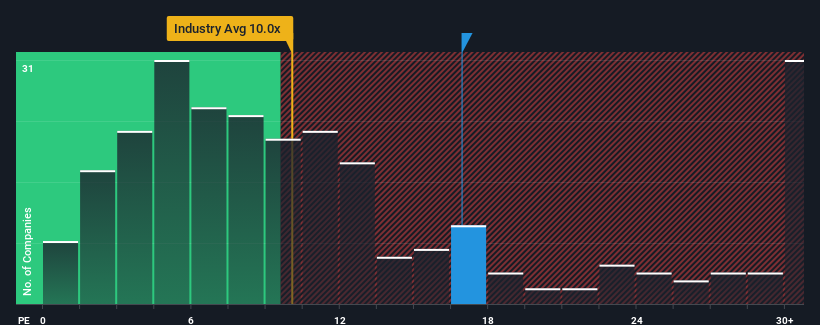- Saudi Arabia
- /
- Oil and Gas
- /
- SASE:2222
Saudi Arabian Oil Company (TADAWUL:2222) Looks Inexpensive But Perhaps Not Attractive Enough

With a price-to-earnings (or "P/E") ratio of 16.9x Saudi Arabian Oil Company (TADAWUL:2222) may be sending bullish signals at the moment, given that almost half of all companies in Saudi Arabia have P/E ratios greater than 26x and even P/E's higher than 39x are not unusual. However, the P/E might be low for a reason and it requires further investigation to determine if it's justified.
Saudi Arabian Oil could be doing better as its earnings have been going backwards lately while most other companies have been seeing positive earnings growth. The P/E is probably low because investors think this poor earnings performance isn't going to get any better. If this is the case, then existing shareholders will probably struggle to get excited about the future direction of the share price.
View our latest analysis for Saudi Arabian Oil

Does Growth Match The Low P/E?
The only time you'd be truly comfortable seeing a P/E as low as Saudi Arabian Oil's is when the company's growth is on track to lag the market.
Retrospectively, the last year delivered a frustrating 19% decrease to the company's bottom line. Even so, admirably EPS has lifted 127% in aggregate from three years ago, notwithstanding the last 12 months. So we can start by confirming that the company has generally done a very good job of growing earnings over that time, even though it had some hiccups along the way.
Shifting to the future, estimates from the analysts covering the company suggest earnings growth is heading into negative territory, declining 1.4% per year over the next three years. That's not great when the rest of the market is expected to grow by 17% per annum.
With this information, we are not surprised that Saudi Arabian Oil is trading at a P/E lower than the market. However, shrinking earnings are unlikely to lead to a stable P/E over the longer term. There's potential for the P/E to fall to even lower levels if the company doesn't improve its profitability.
The Final Word
Generally, our preference is to limit the use of the price-to-earnings ratio to establishing what the market thinks about the overall health of a company.
We've established that Saudi Arabian Oil maintains its low P/E on the weakness of its forecast for sliding earnings, as expected. Right now shareholders are accepting the low P/E as they concede future earnings probably won't provide any pleasant surprises. Unless these conditions improve, they will continue to form a barrier for the share price around these levels.
And what about other risks? Every company has them, and we've spotted 2 warning signs for Saudi Arabian Oil (of which 1 shouldn't be ignored!) you should know about.
It's important to make sure you look for a great company, not just the first idea you come across. So take a peek at this free list of interesting companies with strong recent earnings growth (and a low P/E).
New: Manage All Your Stock Portfolios in One Place
We've created the ultimate portfolio companion for stock investors, and it's free.
• Connect an unlimited number of Portfolios and see your total in one currency
• Be alerted to new Warning Signs or Risks via email or mobile
• Track the Fair Value of your stocks
Have feedback on this article? Concerned about the content? Get in touch with us directly. Alternatively, email editorial-team (at) simplywallst.com.
This article by Simply Wall St is general in nature. We provide commentary based on historical data and analyst forecasts only using an unbiased methodology and our articles are not intended to be financial advice. It does not constitute a recommendation to buy or sell any stock, and does not take account of your objectives, or your financial situation. We aim to bring you long-term focused analysis driven by fundamental data. Note that our analysis may not factor in the latest price-sensitive company announcements or qualitative material. Simply Wall St has no position in any stocks mentioned.
About SASE:2222
Saudi Arabian Oil
Operates as an integrated energy and chemical company in the Kingdom of Saudi Arabia and internationally.
Excellent balance sheet with acceptable track record.


